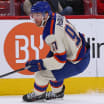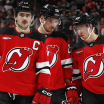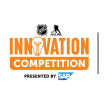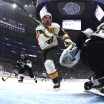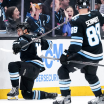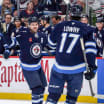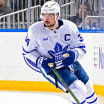Mailbag: John Tavares' future, offside rule
NHL.com's Dan Rosen answers weekly questions
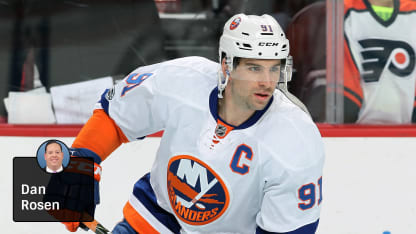
Hypothetical: It's July 2, John Tavares hasn't re-signed with the New York Islanders. Who is he talking to and where is he headed? -- @briantodd34
He's talking to the Islanders and he's staying with the Islanders. Give this some time. If he's not signed after July 1, when he can first sign a contract extension with New York, it will be a story, but it doesn't mean he's not coming back. I think Tavares, who would be an unrestricted free agent after next season, will re-sign with the Islanders. I believe him when he says he wants to stay, and I think ownership will show him the money. I also think it helps that Doug Weight stayed on as coach. Tavares has a terrific relationship with Weight.
However, if this goes deeper into July and it becomes more and more worrisome for the Islanders to re-sign him, I could see a bidding war for him next offseason. If that happens, look for the Montreal Canadiens to make a huge push. They need a franchise center in the worst way.
How do the Pittsburgh Penguins find ways to win so much? They've been dominated for a good portion of the playoffs but still win. -- @hstempin92
They're resilient. They have world-class players who do not need many chances to score. They've had Grade A goaltending, and coach Mike Sullivan is excellent at making in-series adjustments to get the most out of his team. That's why.
Now, in terms of getting dominated, I'd agree with that in terms of shots on goal in the first two rounds of the Stanley Cup Playoffs. The Penguins were outshot 423-332, an average of 7.6 shots per game, yet they outscored the Columbus Blue Jackets and Washington Capitals 41-31 in eliminating them. That's part good, part opportunistic, part luck. Pittsburgh outshot the Ottawa Senators in five of the seven games they played in the Eastern Conference Final, including each of the last four by an average of 12.25 per game. That is a big reason the Penguins got to the Stanley Cup Final. They generated more chances and scored the one more goal they needed in Game 7 against the Senators.
As for Game 1 of the Stanley Cup Final, that was a combination of the Penguins not playing up to their standards and the Nashville Predators suffocating them. The Penguins were slow, lacked energy, not crisp and not very smart either. Combine that with the Predators being aggressive in their pressure and puck pursuit and that's a big reason the Penguins generated 12 shots on goal and went 37:00 without one. But, again, back to that opportunistic part: Pittsburgh scored five goals on those 12 shots. The Penguins gave up a three-goal lead but responded, showing their resiliency.
Regarding the offside rule, can we change it to eliminate considering the back skate touching the ice and make it the location of the skate? -- @themoose0221
NHL general managers have to make the recommendation for any rule change. They discussed this in March, and it went nowhere.
The discussion was about changing the language of the offside rule to allow for a player to be onside as long as one of his skates has broken the vertical plane of the blue line regardless if it is in contact with the ice. The GMs opted against making any changes for two reasons: The first is, they feel it would still require the officials to make a determination if the skate was in the air, which can be as subjective as determining if the skate was on the ice. They also feel it could encourage a player to lift his skate into the air, which is discouraged because of player safety.
One other idea was brought up in a conversation I was having with a few media members. We talked about extending the zone for offside to the width of the blue line, instead of having to have the puck completely cross the blue line. That might take away from some of these close calls we're seeing, which result from a coach's challenge for a goal scored. It's an interesting concept.
Instant replay this season, including the playoffs, is there room for improvement or is it just right? -- @CVancheri
Offside is mostly black and white, and with the camera angles the officials have to look at, there are very few instances when you can argue they aren't getting the call right after video review. Argue the rule all you want, but they have to call the rule as it is written.
Goalie interference is a judgment call, regardless if it's a live look or a video review. That one was always going to be a tougher call for the officials on a coach's challenge. However, NHL Deputy Commissioner Bill Daly brought up an interesting possibility when he said there is the potential for further discussion for centralizing the reviews for goals challenged for potential goalie interference. That means taking it out of the hands of the officials on the ice and allowing the NHL Situation Room in Toronto to make the call. There are different on-ice officials every game, and because goalie interference is subjective, each could see it differently or have his own opinion on it. The thought is, going to a centralized location for that review would cut down on the subjectivity by allowing the same person (or persons) to make the call. It would, in theory, create the potential for more consistency. That is not official, it's just something that might be discussed. I think it should be.
What are your thoughts on bringing back the red line? -- @ByattGraham
I don't think the game needs the red line other than as a dividing line through center ice. It was taken out to speed up the game, and that has done that. You can argue it has made the game too fast and has taken away some of the strategy of getting through the neutral zone, but I'd argue if you put it back in, it will slow down the game too much and won't increase offense. If anything, it could decrease offense. It might add some strategy, but a slow game with strategy doesn't necessarily make for an exciting game.
Where does Scott Stevens end up coaching next season? -- @scomvp
I'm not sure he will coach next season.
Stevens resigned as an assistant for the Minnesota Wild
because he wanted to spend more time with his family. He calls New Jersey home and might decide to go back to the NHL Network and be an analyst. The network is located in Secaucus, New Jersey, not far from where Stevens lives. Maybe New Jersey Devils coach John Hynes wants to try to get him on his staff. That would be a great get for Hynes to let Stevens coach the defense and run the penalty kill. He had a big impact on the Wild in those areas this season.




